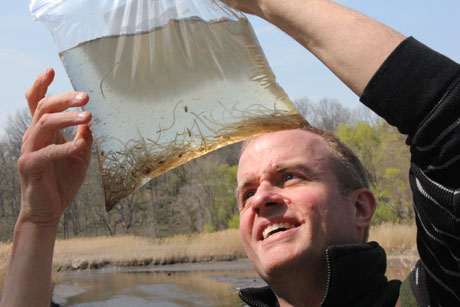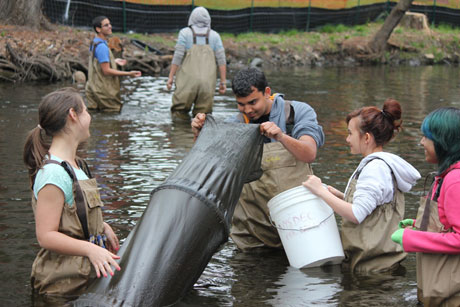Eel expert Bowser wins distinguished EPA award
By Blaine Friedlander


For freshwater environmental education projects and for helping save the American eel in the New York City region, Chris Bowser, an extension support specialist for Cornell’s New York State Water Resources Institute, has won a 2014 U.S. Environmental Protection Agency Environmental Quality Award.
“Chris has not only contributed to our scientific knowledge of eels and helped educate community members about eels, but through his citizen science eel project, he has fostered community engagement,” said Susan Riha, Cornell’s Charles L. Pack Professor in Earth and Atmospheric Sciences and director of the New York State Water Resources Institute. “This is important to all of us who want to cultivate better participation and a greater public understanding of water resource management issues.”
The EPA presents Environmental Quality Awards annually during Earth Week to individuals, businesses, government agencies, and environmental and community-based organizations. Judith A. Enck, EPA regional administrator, presented the award to Bowser April 23.
American eels (Anguilla rostrata), a species in decline due to many environmental pressures, migrate from the Atlantic Ocean and enter freshwater estuaries including the Hudson River. These so-called tiny “glass eels” are a key component of the river ecosystem.
From Mill Creek on Staten Island to Furnace Brook in Cortlandt and Hannacroix Creek in New Baltimore, Bowser, who also receives support from the New York State Department of Environmental Conservation, engages hundreds of high school students, youth groups, college students and community volunteers to study glass eel migration in Hudson tributaries and promote stewardship of the fish.
Each spring, teams of scientists, students and community volunteers wade in the water, gather data and collect glass eels using net and trap devices at several Hudson River tributary locations. The juvenile fish are counted, weighed and released.
Eel numbers have been on the rise recently: In 2012, volunteers caught an average of 144 glass eels per day, and in 2013 they caught an average of 199 glass eels daily. “This is a significant increase from previous years during which the average catch per day was around 20 to 30 eels,” Bowser said. “But we really don’t know why, and we can’t say if this is a trend or just a few good years.”
Bowser says that in 2013, more than 500 volunteers monitored 10 sites from New York City to Greene County, and more than 100,000 glass eels were caught. To give them access to better habitat, most of these eels were released above dams and barriers, Bowser said.
Like the proverbial canary in the coalmine, eels are a good way to measure water system health. “Eels are a great connector for all of New York’s waterways since they rely on the whole system, from small headwater streams and neighborhood creeks to big rivers and coastal estuaries,” Bowser said.
Media Contact
Get Cornell news delivered right to your inbox.
Subscribe